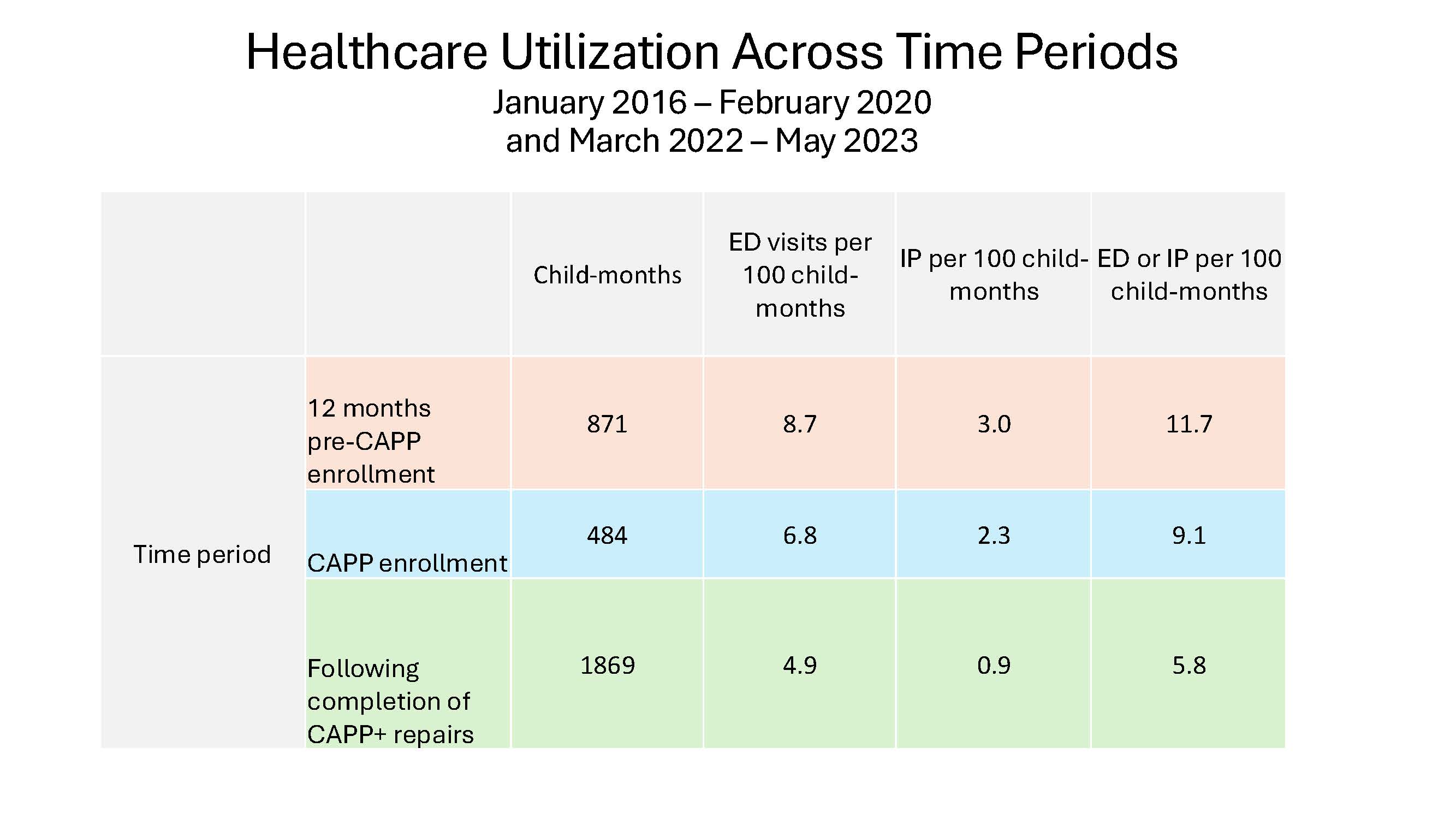Back
Background: Asthma disparities are driven by historical and current social injustices which impact accessibility, quality and affordability of healthy housing. Children who live in poor housing conditions are more likely to have asthma exacerbations. Community Asthma Prevention Program (CAPP), a long-standing Philadelphia asthma home visit program, implemented a home repair intervention (CAPP+) to improve housing conditions through structural repairs to reduce exposure to common triggers including, mice, cockroaches, dust, and mold for children with asthma living in under-resourced Philadelphia neighborhoods.
Objective: The aim of this analysis is to describe longitudinal changes in emergency department (ED) visits and inpatient admissions among children enrolled in CAPP+.
Design/Methods: CAPP+ home remediations included roof and plumbing repairs, carpet removal, and pest exclusion. Children who received CAPP+ repairs between 2018 and 2022 were included in this analysis. We observed asthma-related ED visits and inpatient admissions between January 2017 and May 2023. The study observation window was divided into the following periods: 1) 12 months before CAPP enrollment; 2) months following CAPP enrollment and before CAPP+ enrollment; and 3) months after CAPP+ enrollment until May 2023. We calculated ED and inpatient service utilization per 100 child-months for each time period. Child-months between March 2020 and February 2022 were excluded from analysis due to secular changes in asthma-related healthcare service utilization during the COVID-19 pandemic.
Results: The cohort consisted of 101 children who received CAPP+ repairs for a combined total of 3,224 child-months of observation. ED visits declined from 8.7 per 100 child-months in the 12 months before CAPP enrollment to 4.9 following CAPP+ repairs. Inpatient admissions also declined from 3.0 per 100 child-months before CAPP enrollment to 0.9 per 100 child-months following completion of CAPP+ repairs.
Conclusion(s): We find children receiving home repairs to address asthma triggers had fewer asthma-related ED visits and inpatient admissions following completion of home repairs compared to the pre-intervention period. Though ethical considerations precluded use of a control group, this early evidence suggests that community-based interventions addressing root causes of asthma disparities may improve clinical outcomes among children with asthma in urban settings. Future analysis should examine the differential impact of specific repairs, as well as the impact of repairs on other child- and family-level health and wellbeing measures.
Healthcare Utilization across Time Periods; Jan 2016-Feb 2020 and March 2022-May 2023
 Reduction in asthma-related emergency visits and inpatient visits as compared to 12 months prior to enrollment.
Reduction in asthma-related emergency visits and inpatient visits as compared to 12 months prior to enrollment.
Asthma 1
Session: Asthma 1
476 - Structural Home Repairs to Reduce Asthma Triggers: A longitudinal look at impact on healthcare utilization
Sunday, April 27, 2025
8:30am – 10:45am HST
Tyra Bryant-Stephens, Children's Hospital of Philadelphia, ELKINS PARK, PA, United States; Jaime M. Fluehr, CHOP, Wyncote, PA, United States; Douglas Strane, Children's Hospital of Philadelphia, Philadelphia, PA, United States

Tyra Bryant-Stephens, MD (she/her/hers)
Attending Physician
Children's Hospital of Philadelphia
ELKINS PARK, Pennsylvania, United States
Presenting Author(s)
Background: Asthma disparities are driven by historical and current social injustices which impact accessibility, quality and affordability of healthy housing. Children who live in poor housing conditions are more likely to have asthma exacerbations. Community Asthma Prevention Program (CAPP), a long-standing Philadelphia asthma home visit program, implemented a home repair intervention (CAPP+) to improve housing conditions through structural repairs to reduce exposure to common triggers including, mice, cockroaches, dust, and mold for children with asthma living in under-resourced Philadelphia neighborhoods.
Objective: The aim of this analysis is to describe longitudinal changes in emergency department (ED) visits and inpatient admissions among children enrolled in CAPP+.
Design/Methods: CAPP+ home remediations included roof and plumbing repairs, carpet removal, and pest exclusion. Children who received CAPP+ repairs between 2018 and 2022 were included in this analysis. We observed asthma-related ED visits and inpatient admissions between January 2017 and May 2023. The study observation window was divided into the following periods: 1) 12 months before CAPP enrollment; 2) months following CAPP enrollment and before CAPP+ enrollment; and 3) months after CAPP+ enrollment until May 2023. We calculated ED and inpatient service utilization per 100 child-months for each time period. Child-months between March 2020 and February 2022 were excluded from analysis due to secular changes in asthma-related healthcare service utilization during the COVID-19 pandemic.
Results: The cohort consisted of 101 children who received CAPP+ repairs for a combined total of 3,224 child-months of observation. ED visits declined from 8.7 per 100 child-months in the 12 months before CAPP enrollment to 4.9 following CAPP+ repairs. Inpatient admissions also declined from 3.0 per 100 child-months before CAPP enrollment to 0.9 per 100 child-months following completion of CAPP+ repairs.
Conclusion(s): We find children receiving home repairs to address asthma triggers had fewer asthma-related ED visits and inpatient admissions following completion of home repairs compared to the pre-intervention period. Though ethical considerations precluded use of a control group, this early evidence suggests that community-based interventions addressing root causes of asthma disparities may improve clinical outcomes among children with asthma in urban settings. Future analysis should examine the differential impact of specific repairs, as well as the impact of repairs on other child- and family-level health and wellbeing measures.
Healthcare Utilization across Time Periods; Jan 2016-Feb 2020 and March 2022-May 2023
 Reduction in asthma-related emergency visits and inpatient visits as compared to 12 months prior to enrollment.
Reduction in asthma-related emergency visits and inpatient visits as compared to 12 months prior to enrollment.
